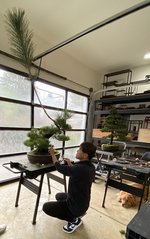You don't urgently need ground growing to thicken trunks unless you are looking to compete on thickness with Telperion or other famous field growers. Ground growing is the go-to answer for the easiest fastest way to make it happen, but not the only way to make it happen. There are plenty of us thickening trunks in other ways: Larger containers, stacking containers, use of airy containers, use of coarse aggregate media, and most importantly / most effectively out of all of these, the use of
running growth.
People who ground grow are mostly putting that running growth into the ground. You can also send running growth into the sky if you want too. For illustration purposes see this photo I took a couple weeks ago, with a big "poodle" of a sacrificial runner powering a lot of wound-healing, post-repot recovery, bud generation, surplus energy for decandling, etc. Yes, I know, that trunk was mostly thickened in the ground originally, but if you have a poodle this big on a
small conifer (as I do on many of my pines), then you can thicken trunks quite fast too. Stack containers (esp. in a climate that is mild enough for redwoods (assuming sequoia) like yours or mine) and ground growing actually starts to look like a hassle in comparison (albeit with some strong benefits if you can ride that rodeo skillfully). It does mean that you will have trees that can't be shown while you're developing them, but that's true of the ground-grown trunks too.

For your other question:
What is keeping it from forming branches too high on the trunk as if it was growing normally?
Those redwoods near your house had branches or could-become-a-branch-fronds 1 inch off the ground, 5 inches off the ground, 1 foot off the ground, 2 feet off the ground, and so on continuously as they grew to each successive size. They didn't form their first branch at 5 or 15 feet off the ground. They abandoned those small branches during the first few years of growth because they weren't viable. Why weren't they viable? Because the tree wants to be big by default and the roots are so unconstrained, and all the viable branches point UP. When they point up, they shade out fronds/branches below and win over those weaker parts. Weaker parts get abandoned, the strong get stronger.
So as a grower of a conifer trunk of a future bonsai, watching branches exist at heights that you want for a future design, you will need to ask yourself every season throughout the trunk-growing process "
how will keep this branch viable? How will I ramify it before the window closes to ever do that?". The answer is that you need to work your conifers as they pass these points-of-no-return and do the necessary things to convert those "
passed points of no return" into "
opportunities taken advantage of just before the window closed". You need to wire those branches down, selectively weaken growth outside of the silhouette above, and shorten "keep" branches (borrowing a
@Brian Van Fleet term) occasionally to prevent them from having interior growth out-muscled by exterior growth of their own. The mistake would be to blow past these various points of no return (whether for the whole tree or for individual branches) and magically expect back budding to save the tree later on. It can in some cases, with redwood too (depending on what "redwood means"), but not always/usually/often.
This is just the tip of the iceberg though. Ideally you figure out who in the bonsai community is doing this kind of work and study what they're doing carefully at every stage, because there are a lot of details depending on which species you're growing. With conifers the urgency to act on opportunities is higher than with deciduous broadleaf, moreso if you are growing shohin. But there are folks who are thickening trunks in containers and also managing to keep future branches under control while not impeding vigor.
Keep your eye on growth and always be asking questions like "
am I missing an opportunity to strengthen something that's about to get weakened?" and "
why would this shoot be weaker than that other shoot? what can I do to make it more successful?". Even during trunk growing these are relevant questions, and this is truer the smaller your target design size is.

